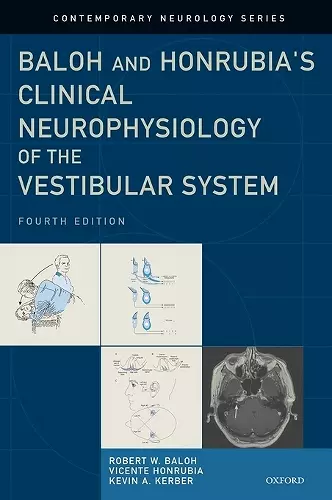Baloh and Honrubia's Clinical Neurophysiology of the Vestibular System
Robert W Baloh, MD, FAAN author Vicente Honrubia, MD, DMSc author Kevin A Kerber, MD author
Format:Hardback
Publisher:Oxford University Press Inc
Published:16th Dec '10
Currently unavailable, and unfortunately no date known when it will be back

This book provides a framework for understanding the pathophysiology of diseases involving the vestibular system. The book is divided into four parts: I. Anatomy and physiology of the vestibular system; II. Evaluation of the dizzy patient; III. Diagnosis and management of common neurotologic disorders; and IV. Symptomatic treatment of vertigo. Part I reviews the anatomy and physiology of the vestibular system with emphasis on clinically relevant material. Part II outlines the important features in the patient's history, examination, and laboratory evaluation that determine the probable site of lesion. Part III covers the differential diagnostic points that help the clinician decide on the cause and treatment of the patient's problem. Part IV describes the commonly used antivertiginous and antiemetic drugs and the rationale for vestibular exercises. The recent breakthroughs in the vestibular sciences are reviewed. This book will helpful to all physician's who study and treat patients complaining of dizziness.
"This thoroughly updated and expanded fourth edition of Clinical Neurophysiology of the Vestibular System represents a significant contribution to the understanding of the vestibular system in health and disease. A comprehensive knowledge on the physiology and pathophysiology of the human balance system is essential for the diagnosis and treatment of patients with vestibular dysfunction. By covering all these aspects along with the clinical context, Drs. Baloh and Kerber are truly in the tradition of Robert Bárány, who founded the discipline of clinical neurotology more than hundred years ago. The clearly written text and the illustrative graphic design make this book a valuable reference tool for physicians, clinical specialists, and researchers alike. With its meanwhile fourth edition, Clinical Neurophysiology of the Vestibular System is sure to become a classic in its field." --Gerald Wiest, MD, Department of Neurology, Medical University of Vienna, Vienna, Austria "The long-awaited revision of this well-known monograph. As before, a thorough, comprehensive clear, authoritative and now up-to-date account of the clinical neurophysiology of the vestibular system reflecting 35 years of clinical and research experience by one of the giants of modern neuro-otology. The clinical features, mechanisms, causes and treatment of all the common vestibular disorders reviewed in a practical and helpful way. An essential addition to the library of any practitioner dealing with dizzy patients" --Prof, Dr G Michael Halmagyi, Neurology Department, Royal Prince Alfred Hospital, Camperdown NSW 2050, Sydney, Australia "This exciting and much-awaited new edition of "Clinical Neurophysiology of the Vestibular System" exceeds expectations. It has been prepared by authorities in the field: it is up-to-date, clear and exceptionally well written. The first chapters guide the reader through the basic principles. The following chapters deal with evaluation and treatment of common vestibular disorders and they include numerous hands-on instructions for the practitioner. This textbook truly offers a solid and comprehensive reference base for anyone with an interest in neuro-otology." --Professor Krister Brantberg, Karolinska Hospital, Stockholm, Sweden "[This] revised third editionELis a welcome, and much-needed, resource. Updating the clinical and basic science without losing the logical coherence of this book's organization has been accomplished, and the classical underpinnings have been blended carefully with many recent changes in understandingEL.This new edition...brings up to date much of the physiology, neurology and clinical information related to the inner ear, its neurologic connections, and disorders of balance and hearing. It fills an important gap in the understanding of these problems for neurologists and otologists alike. At a time when physicians tend to get quick answers from a brief search of a website, this book deserves to be studied, to earn a place on the office reference shelf, and to have its knowledge incorporated into the thinking of every well-trained neurologist." --David A Drachman, MD, Professor and chairman emeritus, Department of Neurology, University of Massachusetts Medical Center, Boston, MA
ISBN: 9780195387834
Dimensions: 183mm x 257mm x 25mm
Weight: 1233g
480 pages
4th Revised edition